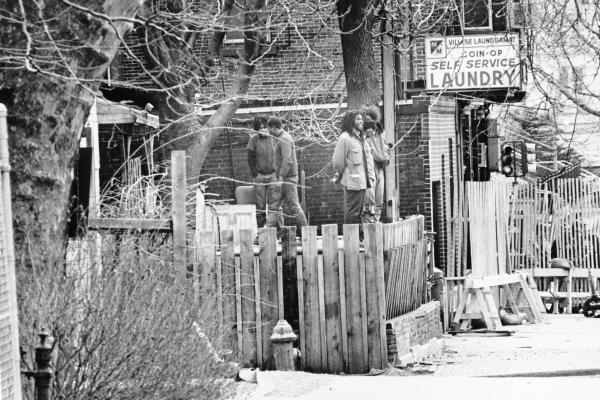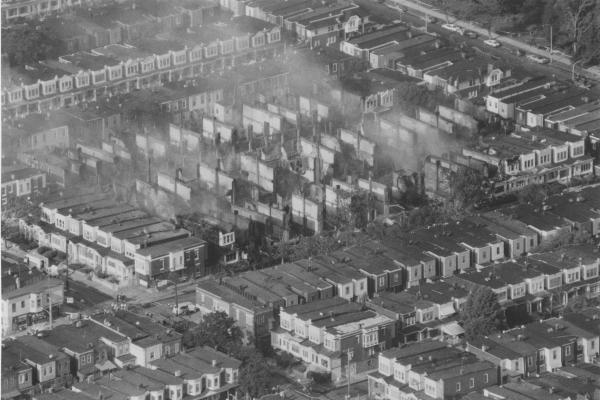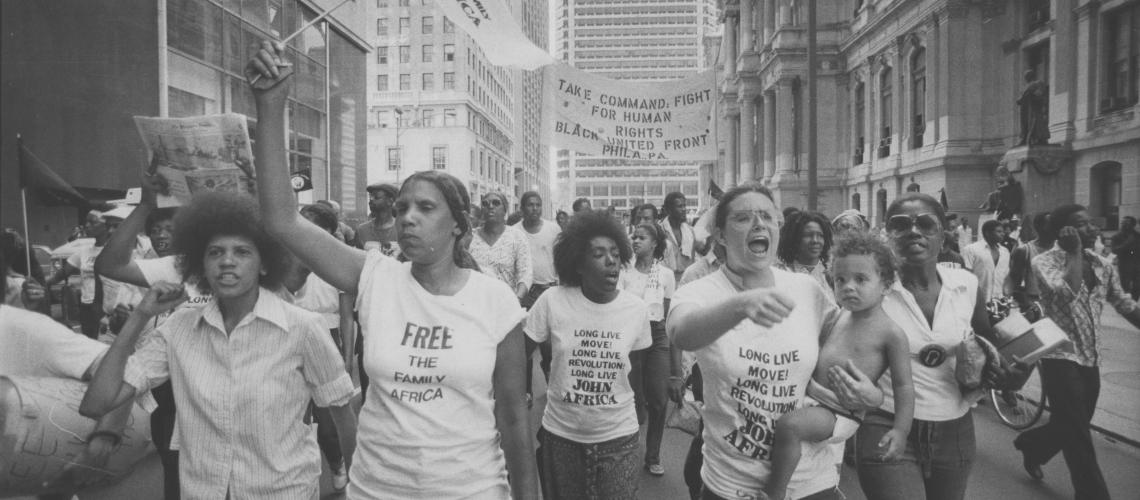MOVE demonstrators marched to City Hall in August 1979 to protest the imprisionment of members charged with murdering a police officer during a confrontation in Powelton Village the previous year.
Though the MOVE organization is notoriously famous by dint of the tragic 1985 MOVE fire, an event that shook the city to its core and ramifies even today, their history in West Philadelphia spans more than forty years, from the mid-1970s to the late-2010s.
In 1973, MOVE formed around the principles of John Africa (formerly Vincent Leaphart), which called for a vigorous rejection of the norms and conventions of modern technological society. The disruptive lifestyle of MOVE members led to conflict with neighbors and the police. Tensions came to a head in a standoff in Powelton Village in 1978, which resulted in the death of a police officer, and the arrest and long-term imprisonment of nine MOVE members. In 1982, MOVE relocated to Osage Avenue near Cobbs Creek Park where a confrontation over similar issues led to a more devastating result. The MOVE fire of May 13, 1985 killed 11 MOVE members and destroyed 61 neighborhood homes. In the aftermath, two investigations excoriated city officials’ decision-making in the making of the tragedy. For more than 30 years, corruption and improprieties have plagued attempts to rebuild the burned Osage Avenue houses. In the 1990s, the remaining members of MOVE relocated peacefully to the Spruce Hill neighborhood, and the organization remains a politically active presence in Philadelphia.
Stories in this Collection
 1973–1978 In 1973, a group of West Philadelphians—guided by the anti-establishment principles of charismatic Mantua resident, Vincent Leaphart (later self-renamed John Africa)—came together as MOVE. MOVE (not an acronym) adopted a radically alternative lifestyle and militant political practices that created antagonistic relationships with both their neighbors and the Philadelphia Police Department. In August 1978, after almost a year of failed negotiations to resolve an earlier conflict, Mayor Frank Rizzo ordered an attack on MOVE’s Powelton Village headquarters that resulted in the destruction of the headquarters, the death of a police officer, and the virtual life sentences of nine MOVE members. |
 1982–1985 In 1982, some of the MOVE members who had escaped incarceration following the 1978 shootout with Philadelphia police in Powelton Village, settled into a rowhouse at 6221 Osage Avenue, where they broadcasted demands to the city through a loudspeaker day and night. Complaints voiced by neighborhood residents were tabled at City Hall, even as MOVE members constructed an armed barricade on the roof of the house. Under mounting pressure to act, Mayor Wilson Goode authorized a tactical plan to evict MOVE. On May 13, 1985, the eviction process went awry, resulting in a day-long gun battle between MOVE and city police. In the early evening, a satchel bomb dropped from a police helicopter onto the barricade ignited a fire that the fire department failed to control. The fire caused the deaths of 11 of 13 MOVE members (six adults and five children), destroyed two city blocks of middle-class homes, and left an indelible stain on the city’s reputation (“The city that bombed itself”). |
 1985–2018 Two investigations in the wake of the MOVE fire cited the city’s four top officials for negligence and incompetence in their management of the situation. The city’s efforts to replace the area’s destroyed houses were frustrated by corruption and shoddy construction. From the early 1990s MOVE survived and thrived in a remnant form, resettling in the Spruce Hill neighborhood, living peacefully with neighbors, taking up the cause of the imprisoned activist Mumia Abul-Jamal, and continuing to work for the release of the surviving members of the MOVE 9. |
